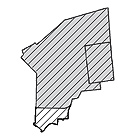The Ayyubid Period, 1187 -1250 CE
|

|
At the beginning of the period the city walls were reinforced and fortifications were constructed and when it ended Jerusalem was an open city, no longer enclosed in a wall. In 1178 CE Saladin entered Jerusalem via a breach in the northern wall, opposite the Rockefeller Museum, through which the Crusaders entered. Several years after the conquest, probably because participants in the Third Crusade were still present in Israel (1192) Saladin began rehabilitating and fortifying the city walls that were mostly neglected during Crusader rule. Saladin took an active part in the treatment of the walls in order to set a personal example for his commanders and soldiers.
Between 1202-1212 CE Saladin's brother al-A'adal continued fortifying the city while shortening the course of the wall in the south and adding large strong towers to it.
In 1219 CE a great change took place when Jerusalem ceased to be a fortified city. The Ayyubids apparently feared the city would be conquered by the Crusaders and they therefore adopted a scorched earth policy whereby Al-Malak al-Ma'atam Isa demolished the city walls. Toward the end of this period, during the 13th century (1229-1244), the Crusaders once again ruled Jerusalem but did not leave their mark there.
Finds:
There are inscriptions from the Ayyubid period that commemorate important dates during the construction of the city walls and towers.
|
|

|
| The city wall in the Ayyubid period |
|















